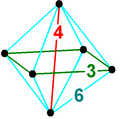Top Qs
Timeline
Chat
Perspective
Bitruncated tesseractic honeycomb
From Wikipedia, the free encyclopedia
Remove ads
In four-dimensional Euclidean geometry, the bitruncated tesseractic honeycomb is a uniform space-filling tessellation (or honeycomb) in Euclidean 4-space. It is constructed by a bitruncation of a tesseractic honeycomb. It is also called a cantic quarter tesseractic honeycomb from its q2{4,3,3,4} construction.
| Bitruncated tesseractic honeycomb | |
|---|---|
| (No image) | |
| Type | Uniform 4-honeycomb |
| Schläfli symbol | t1,2{4,3,3,4} or 2t{4,3,3,4} t1,2{4,31,1} or 2t{4,31,1} t2,3{4,31,1} q2{4,3,3,3,4} |
| Coxeter-Dynkin diagram |
|
| 4-face type | Bitruncated tesseract Truncated 16-cell |
| Cell type | Octahedron Truncated tetrahedron Truncated octahedron |
| Face type | {3}, {4}, {6} |
| Vertex figure |  Square-pyramidal pyramid |
| Coxeter group | = [4,3,3,4] = [4,31,1] = [31,1,1,1] |
| Dual | |
| Properties | vertex-transitive |
Remove ads
Other names
- Bitruncated tesseractic tetracomb (batitit)
Related honeycombs
The [4,3,3,4], ![]()
![]()
![]()
![]()
![]()
![]()
![]()
![]()
![]() , Coxeter group generates 31 permutations of uniform tessellations, 21 with distinct symmetry and 20 with distinct geometry. The expanded tesseractic honeycomb (also known as the stericated tesseractic honeycomb) is geometrically identical to the tesseractic honeycomb. Three of the symmetric honeycombs are shared in the [3,4,3,3] family. Two alternations (13) and (17), and the quarter tesseractic (2) are repeated in other families.
, Coxeter group generates 31 permutations of uniform tessellations, 21 with distinct symmetry and 20 with distinct geometry. The expanded tesseractic honeycomb (also known as the stericated tesseractic honeycomb) is geometrically identical to the tesseractic honeycomb. Three of the symmetric honeycombs are shared in the [3,4,3,3] family. Two alternations (13) and (17), and the quarter tesseractic (2) are repeated in other families.
The [4,3,31,1], ![]()
![]()
![]()
![]()
![]()
![]()
![]() , Coxeter group generates 31 permutations of uniform tessellations, 23 with distinct symmetry and 4 with distinct geometry. There are two alternated forms: the alternations (19) and (24) have the same geometry as the 16-cell honeycomb and snub 24-cell honeycomb respectively.
, Coxeter group generates 31 permutations of uniform tessellations, 23 with distinct symmetry and 4 with distinct geometry. There are two alternated forms: the alternations (19) and (24) have the same geometry as the 16-cell honeycomb and snub 24-cell honeycomb respectively.
There are ten uniform honeycombs constructed by the Coxeter group, all repeated in other families by extended symmetry, seen in the graph symmetry of rings in the Coxeter–Dynkin diagrams. The 10th is constructed as an alternation. As subgroups in Coxeter notation: [3,4,(3,3)*] (index 24), [3,3,4,3*] (index 6), [1+,4,3,3,4,1+] (index 4), [31,1,3,4,1+] (index 2) are all isomorphic to [31,1,1,1].
The ten permutations are listed with its highest extended symmetry relation:
Remove ads
See also
Regular and uniform honeycombs in 4-space:
Notes
References
Wikiwand - on
Seamless Wikipedia browsing. On steroids.
Remove ads



